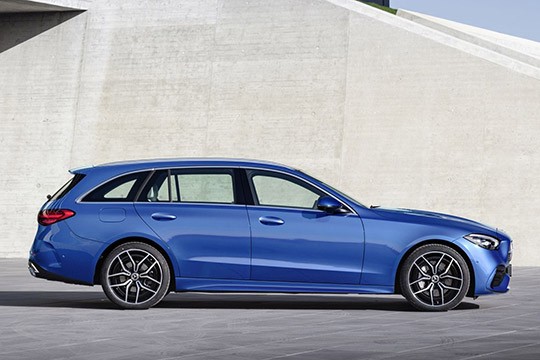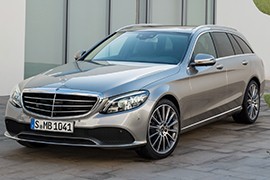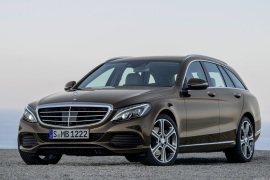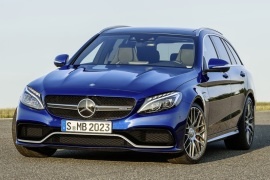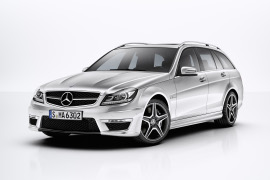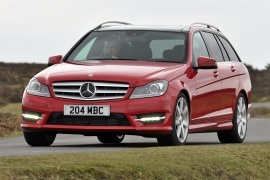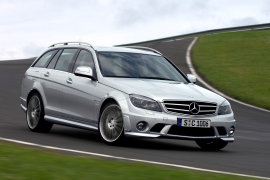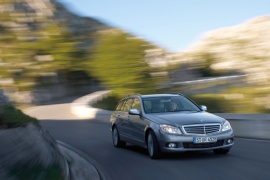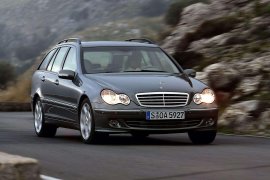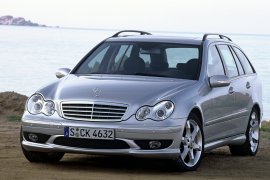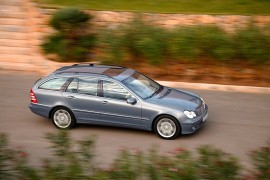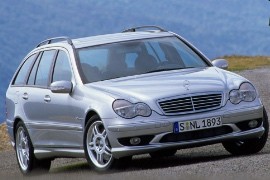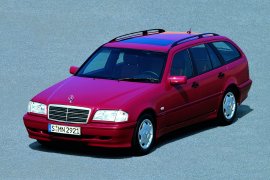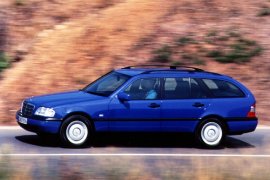MERCEDES BENZ C-Klasse T-Modell Models/Series Timeline, Specifications & Photos
First production year: 1996
Engines: Mild hybrid, Mild hybrid diesel, Gasoline, Diesel, Hybrid
Body style: Wagon (station wagon, estate, combi, touring)
Mercedes-Benz introduced both body versions for the fifth generation of its C-Class range in 2021, and the station-wagon looked more dynamic than before.
The premium German carmaker had a long history with station wagons, and it didn't want to drove them away from the assembly line as long as the customers respected it. It didn't have to. All it had to do was to improve them continuously along with the rest of the range. While its predecessors looked more like family wagons, the 2021 model took a different, sportier approach.
Thanks to its long front end, the C-Class looked sportier than before. That change appeared for the first time on the fourth generation, W205/S205. Then, Mercedes-Benz decided to continue the trend and adopted the same idea on the W206/S206 lineup. Its arched, third side window looked closer to those used for on the CLA shooting-brake.
As usual, the T-model shared most of its parts with its sedan sibling. The carmaker installed the same dashboard with free-standing LCD screens. Customers have a choice between a 10.25" or a 12.3" version. On the center stack, Mercedes-Benz installed another big display tilted toward the driver for the infotainment system, with a standard 9.5" touch-screen and an option for an 11.9". Its trunk area was increased compared to its predecessor and reached 490 liters (17.3 cu-ft), which could have been extended up to 1510 liters (53.3 cu-ft) by completely folding down the 40/20/40 rear bench.
Under the hood, the C-Class S206 started its journey with a new engine lineup. Its downsizing process, combined with the electrification program, led to higher fuel-efficiencies for the entire lineup. At the new generation's start, the car received only automatic transmissions.
Mercedes-Benz introduced a significant refresh for the entire C-Class lineup in 2018 and, while the exterior changes were more subtle, the technological improvement was much more important.
The C-Class was on the market since 1993 and has evolved ever since. Its main competitors were the A4 from Audi and the 3-Series from BMW. Later on, the Jaguar joined the category with the XE, and Alfa Romeo made a stunning comeback with the Giulia. But in the station wagon shape, the C-Class T-Model's opponents remained the German carmakers.
On the outside, the C-Class T-Model received different bumpers for different trim levels. It started with one chromed slat for the standard version and went to up to three chrome-plated trims for the Exclusive version. Its headlights featured a multi-beam system with 84 individual LEDs inside, with an option for ultra range high-beam available as an option. In the back, the power-tailgate was available as an option for lower trim levels and fitted as standard on the upper ones.
The interior went through a major upgrade along with the introduction of the new infotainment system and an option for a full-digital instrument panel with three individual display options. Its touch-sensitive controls from the steering wheel allowed the driver to access the infotainment unit and also access the LINGUATRONIC voice-control system.
Along with the facelifted version, Mercedes-Benz introduced the 2.0-liter turbo-diesel engine on the C-Class T-Model. It was carried over from its bigger brother, the E-Class. The rest of the lineup offered only turbocharged engines. The carmaker paired all versions with a nine-speed automatic transmission, and, for specific engine options, it offered an all-wheel-drive system.
MERCEDES BENZ C-Class T-Modell (S205) C 160 G-TRONIC 9AT (129 HP)
MERCEDES BENZ C-Class T-Modell (S205) C 180 G-TRONIC 9AT (156 HP)
MERCEDES BENZ C-Class T-Modell (S205) C 200 4NATIC G-TRONIC 9AT (198 HP)
MERCEDES BENZ C-Class T-Modell (S205) C 200 G-TRONIC 9AT (198 HP)
MERCEDES BENZ C-Class T-Modell (S205) C 400 V6 4MATIC G-TRONIC 9AT (333 HP)
Mercedes-Benz introduced a new generation of the C-Class in 2014 in both versions, sedan and station wagon, in 2014 and also added the AMG flavor for them in all three versions: sedan, station wagon, and coupe.
The long-roof version of the C-Class, code-named S205, was able to transport more stuff in the back, thanks to its big trunk. In addition, it still provided enough technology onboard to be attractive to the younger generation. Last but not least, it was a genuine, comfortable daily driver.
The C-Class 450 AMG T-Modell featured the specific, A-shaped lower grille in the bumper, flanked by a pair of air intakes that channeled the air to the front brakes. The main grill sported a 3D pattern named "diamond mesh" crossed by a single chromed bar that supported the brand's logo. The long roof version featured a third row of windows between the C- and D-pillars. Finally, at the back, the raked-forward tailgate was adorned with a roof spoiler, while below the rear bumper, AMG installed a splitter flanked by four exhausts.
Inside, the sports seats were covered in AMG-specific upholstery and provided excellent side support during high-speed cornering thanks to the adjustable bolstered areas. In addition, the ARTICO/DINAMICA man-made leather mixed with the aluminum trims provided a sporty ambiance. Inside the instrument cluster, the carmaker placed a pair of dials with chequered flag background and red needles. In the middle, a small TFT display showed the onboard computer data. At the back, the automaker installed a split-folding bench that expanded the trunk area from 490 liters (17.3 cu-ft) to 1510 liters (53.3 cu-ft).
Under the hood, AMG installed a twin-turbo 3.0-liter V6 engine paired with a seven-speed 7G-TRONIC PLUS gearbox. Power went in all corners with a front/rear 33/67 torque-split distribution.
MERCEDES BENZ C 450 AMG T-Modell (S205) 450 AMG 4MATIC 7AT (367 HP)
The Mercedes-Benz C-Class has its place in the premium compact segment. In 2014, the station-wagon version of the W205 C-Class model was launched. And it changed perspectives.
The T-Model version had a long history in the Mercedes-Benz models lineup and the C-Class always had a station-wagon variant, and the 2014 model was the third generation of it. Mercedes-Benz's idea was to give the car a sporty look.
It had the same lines as the sedan, up to the B-pillar, and the same front fascia. The longer roof had roof-rails on top and a spoiler on top of the liftgate, which could be opened electrically via a foot-swipe move under the rear bumper. As an option, a panoramic glass-roof was available.
When compared to its predecessor, it had a bigger longer wheelbase by 80 mm (3.14"), which lead to bigger legroom for the rear passengers. The total trunk space reached 490 liters (17.3 cu-ft) of space that could be extended up to 1510 liters (53.3 cu-ft). The sloped rear end made the car look sportier, despite its family-look. The rear seats could have been folded in a split 40-20-40 ratio, unlike the 40-60 as the previous generation. The rear passenger head-room in the back was bigger than in the sedan version.
The estate version was available with a choice of gasoline or diesel engines, with an automatic or manual transmission, with rear or all-wheel-drive.
Based on the 2014 Mercedes-Benz C-Class station-wagon (S205), the AMG C63 version was the top-performer of its range. It offered the highest power and the best technology to make a luxury car goes faster. It was launched in April 2015.
The C63 AMG was the most successful model of AMG vehicles. The second generation lost the naturally aspirated V8 in favor of a twin-turbo 4.0-liter engine. Unlike its rival, the M3, it was also built as a station-wagon, or T-Model as it was named.
When compared with its siblings from the C-Class T-Model, it featured a more aggressive styling. The wide and short grille with the big badge supported by the twin-aluminum wings. The car had to look aggressive but, in the meantime, its aerodynamic was with a purpose. A chromed “V8 BITURBO” chromed badge was installed on each of the front fenders. The longer roofline was sloped toward the back and on top of the tailgate, it featured a roof-spoiler with the third stop-light.
Inside there were sport-bucket seats for the front passengers. The instrument cluster featured two analog dials with a carbon-fiber background. Between the binocular look of the gauges, there was a small TFT display for the on-board computer. For the rear passengers, there was more headroom than in the sedan version. The trunk space could have been extended by folding the split backrest of the bench.
Under the hood, the C63 T-Model was offered in two versions: C63 and C63S. Both featured special suspension with adaptive dampers and the AMG SPEEDSHIFT MCT 7-speed sports transmission. The dynamic engine mounts were fitted as standard on the more powerful C63S and offered as an option for the non-S version.
In 2011, Mercedes-Benz introduced an essential update for the C-Class range, and the AMG versions went even further than the rest of its siblings.
The T-Model was the long-roof version of the C-Class, and it also received an AMG treatment. Thus, those who had to decide between a sports car and a family vehicle could receive a package of both, with minimal compromises. Besides the visual upgrades, the car also got a new, improved front suspension carried over from its CLK 63 AMG Black Series sibling and a different steering system.
At the front, the carmaker installed a new pair of swept-back headlights, which were shared with the rest of the range, albeit sporting Xenon lights. The lower bumper featured the A-shaped apron with the air-intake, flanked on the sides by the new LED daytime running lights above the side-scoops. On the aluminum hood, the automaker added AMG-specific two powerdomes. At the back, the station wagon received a new pair of taillights that were mounted outside the tailgate area and a discrete roof spoiler. In addition, the rear diffuser sported four oval exhausts.
Inside, the carmaker introduced a new dashboard design with an extended instrument cluster towards the passenger's side, above the center stack. In addition, AMG placed the 6.3 V8 white lettering inside the tachometer on black dials. Even though the carmaker offered high-bolstered front seats, with an option for sport seats, the rear bench was just the regular, split-folding one from the rest of the C-Class T-Model range.
Apart from the regular version, AMG offered a Performance Package option that squeezed 30 more ponies from the engine, raising the bar to 487 hp. The carmaker paired both versions to an AMG Speedshift MCT 7-speed sports transmission and sent the power to the rear wheels.
In 2011 Mercedes-Benz upgraded the C-Class lineup, and along with the sedan and the coupe, it also refreshed the long roof version, known in the carmaker's family as a T-Modell.
Four years after the model's introduction on the market, the German automaker refreshed the C-Class lineup and enhanced the car in all areas. Customers didn't welcome all the changes but appreciated some of them. The station wagon version, or S204 as it was known on the market, was highly appreciated for its ability to provide more interior room while keeping its customers spoiled in a premium environment.
With its new front fascia, the 2011 W204/S204 sparked controversies among its customers. While some argued that it gave the car a unique stance, others considered it uninspired, to say the least. The new headlights were stretched upwards, and the outer bubble design for them didn't fit the design language of the German brand. Conversely, the grille sported three horizontal slats for most versions, and it looked appropriate. While the profile remained virtually unchanged, the rear was modified and sported new taillights that featured LEDs.
Inside, Mercedes-Benz completely changed the dashboard, which now featured an in-dash screen for the infotainment system, placed atop the center stack in a neatly integrated cluster. On the pre-facelifted version, it used a pop-out screen that could rise from inside the dashboard. Among other changes, the carmaker replaced the steering wheel, which received a squared pattern for the buttons mounted on it. As expected, the split-folding rear bench seat expanded the trunk, which remained at the same value as before of up to 1500 liters (52.9 cu-ft).
The drivetrains were also enhanced, and the 7G-Tronic automatic gearbox became available for most versions, replacing the trustworthy but slow 5G-Tronic previously used.
MERCEDES BENZ C-Class T-Modell (S204) C 180 6MT (156 HP)
MERCEDES BENZ C-Class T-Modell (S204) C 180 7AT (156 HP)
MERCEDES BENZ C-Class T-Modell (S204) C 200 6MT (185 HP)
MERCEDES BENZ C-Class T-Modell (S204) C 200 7AT (185 HP)
MERCEDES BENZ C-Class T-Modell (S204) C 250 CDI 7AT (204 HP)
MERCEDES BENZ C-Class T-Modell (S204) C 180 CDI 6MT (120 HP)
MERCEDES BENZ C-Class T-Modell (S204) C 180 CDI 7AT (120 HP)
MERCEDES BENZ C-Class T-Modell (S204) C 200 CDI 6MT (136 HP)
MERCEDES BENZ C-Class T-Modell (S204) C 200 CDI 7AT (136 HP)
MERCEDES BENZ C-Class T-Modell (S204) C 220 CDI 4MATIC 7AT (170 HP)
MERCEDES BENZ C-Class T-Modell (S204) C 220 CDI 6MT (170 HP)
MERCEDES BENZ C-Class T-Modell (S204) C 220 CDI 7AT (170 HP)
MERCEDES BENZ C-Class T-Modell (S204) C 220 CDI BlueEFFICIENCY 6MT (170 HP)
MERCEDES BENZ C-Class T-Modell (S204) C 250 7AT (204 HP)
MERCEDES BENZ C-Class T-Modell (S204) C 250 CDI 4MATIC 7AT (204 HP)
MERCEDES BENZ C-Class T-Modell (S204) C 250 CDI 6MT (204 HP)
MERCEDES BENZ C-Class T-Modell (S204) C 300 CDI 4MATIC 7AT (231 HP)
MERCEDES BENZ C-Class T-Modell (S204) C 350 V6 CDI 7AT (265 HP)
By 2007, Mercedes-Benz AMG was already an established nameplate on the market, and most of the carmaker's models were enhanced by its in-house tuning company, such as this station wagon from the C-Class' third generation.
When Mercedes-Benz introduced the W204/S204 lineup (sedan/station wagon), it already prepared the platform to handle a big V8 powerplant under the hood, and thus it built the C 63 AMG. That it put it in direct competition against BMW's four-door M3. But then it stepped up the game and introduced the C 63 T-Model and entered the contest against the Audi RS4 Avant.
The AMG clearly looked different than the rest of the C-Class T-Model range. Its distinctive front bumper with a lowered apron that sported the A-shaped grille and a pair of round foglamps and air intakes was a sign of a sport-oriented vehicle. The widened wheel-arches that covered the 18" alloys with their multi-spoke design made room for 235/40 ZR tires up front and the 255/35 out back. Under the rear bumper, four oval exhausts were not just provocative but vocal as well. Strangely, though, there was no massive roof-spoiler at the top of the tailgate.
Inside, the AMG-designed interior featured bucket seats with high-bolstered areas and leather upholstery. As an option, a pair of sports seats with high seatback was on the options list, while the rear bench remained similar to the one fitted in any other C-Class station wagon. The instrument cluster looked similar to the one provided in the rest of the range, although there was an AMG lettering in the onboard computer's display fitted inside the speedometer.
Under the hood, Mercedes-Benz installed a hand-crafted 6.2-liter, free-breathing V8 mated to an AMG SPEEDSHIFT PLUS 7G-TRONIC automatic transmission. It sent the power to the rear wheels only.
Just a few months after the unveiling of the third generation of the C-Class (W204), the station-wagon version was introduced. It was launched at the 2007 Frankfurt Motor Show.
The third generation C-Class came into a moment where the previous facelifted version of the W203 faced some reliability issues. To prevent this, the company insisted on extensive testings. By the time of its launch, the C-Class W204 was the most tested vehicle by the German car-maker, with over 24 million kilometers (150 million miles) of testing.
The third generation of the C-Class featured a 5 cm (2") longer wheelbase when compared with the predecessor. That led to almost the same increase in length, just slightly longer. That led to better legroom for the rear passengers, for which the previous generation was criticized. Due to a longer roof, the rear headroom was no longer a problem for tall passengers. It featured a standard 60:40 split rear bench seat, to increase the trunk space. That lead to an increased load volume of up to 1500 liters (52.9 cu-ft) which was 146 liters (5.1 cu-ft) more than on the previous generation.
For the driver and passengers comfort, the C-Class T-Model featured three versions for the audio system: Audio 20, Audio 50, and COMAND APS. The latter featured a GPS navigation system.
MERCEDES BENZ C-Klasse T-Modell (S204) 180 Kompressor 5AT RWD (156 HP)
MERCEDES BENZ C-Klasse T-Modell (S204) 180 Kompressor 6MT RWD (156 HP)
MERCEDES BENZ C-Klasse T-Modell (S204) 200 Kompressor 5AT RWD (184 HP)
MERCEDES BENZ C-Klasse T-Modell (S204) 200 Kompressor 6MT RWD (184 HP)
MERCEDES BENZ C-Klasse T-Modell (S204) 230 6MT RWD (204 HP)
MERCEDES BENZ C-Klasse T-Modell (S204) 230 7AT RWD (204 HP)
MERCEDES BENZ C-Klasse T-Modell (S204) 250 CGI BlueEfficiency 5AT RWD (204 HP)
MERCEDES BENZ C-Klasse T-Modell (S204) 280 6MT RWD (231 HP)
MERCEDES BENZ C-Klasse T-Modell (S204) 280 7AT RWD (231 HP)
MERCEDES BENZ C-Klasse T-Modell (S204) 300 6MT RWD (231 HP)
MERCEDES BENZ C-Klasse T-Modell (S204) 200 CDI 5AT RWD (136 HP)
MERCEDES BENZ C-Klasse T-Modell (S204) 200 CDI 6MT RWD (136 HP)
MERCEDES BENZ C-Klasse T-Modell (S204) 220 CDI 5AT RWD (170 HP)
MERCEDES BENZ C-Klasse T-Modell (S204) 220 CDI 6MT RWD (170 HP)
MERCEDES BENZ C-Klasse T-Modell (S204) 250 CDI 4MATIC 7AT AWD (204 HP)
MERCEDES BENZ C-Klasse T-Modell (S204) 320 CDI 4MATIC 7AT AWD (224 HP)
MERCEDES BENZ C-Klasse T-Modell (S204) 320 CDI 6MT RWD (224 HP)
MERCEDES BENZ C-Klasse T-Modell (S204) 320 CDI 7AT RWD (224 HP)
MERCEDES BENZ C-Klasse T-Modell (S204) 350 CDI 4MATIC 7AT AWD (224 HP)
MERCEDES BENZ C-Klasse T-Modell (S204) 350 CDI 6MT RWD (224 HP)
MERCEDES BENZ C-Klasse T-Modell (S204) 350 CDI 7AT RWD (224 HP)
MERCEDES BENZ C-Klasse T-Modell (S204) 350 CDI BlueEfficiency 7AT RWD (231 HP)
The mid-life refresh for the second generation of the Mercedes-Benz C-Class range brought more power for the engines, exterior, and interior changes.
The C-Class was a success from its start and the second generation was launched in March 2000 at the Geneva Motor Show. Four years later, the facelift appeared with important changes for especially for the diesel versions, which were upgraded from Euro 3 emission standard to the Euro 4. That change added some power, but it also lost the only AMG diesel version.
From the outside, new headlights, new rear-view mirrors, and taillights were added to the car. The body shape remained the same, with only some subtle changes. There were more trim level to choose from, including “Sport Edition” and “Sport Edition +”.
Inside, the instrument cluster was completely redesigned. Instead of a big, large, speedometer in the middle as in the pre-facelift version, the 2004 C-Class featured two round dials for the speedometer and the tachometer. Between them, there was an LCD display for the on-board computer. Also, the steering wheel was redesigned.
For the engine compartment, the 2.1-liter diesel engine was offered with up to 150 hp. It was the most successful engine for the 2004 C-Class T-Model, with almost 81.000 units sold from a total of 373.873 station-wagon produced. For the gasoline units, there was a new option for the 230 Kompressor, which was not available before 2004 for this body shape. The standard transmission was a 6-speed manual while a 5-speed automatic was offered as an option. Also, 4Matic all-wheel-drive versions were upgraded.
MERCEDES BENZ C-Klasse T-Modell (W203) 180 Kompressor 5AT RWD (143 HP)
MERCEDES BENZ C-Klasse T-Modell (W203) 180 Kompressor 6MT RWD (143 HP)
MERCEDES BENZ C-Klasse T-Modell (W203) 200 Kompressor 5AT RWD (163 HP)
MERCEDES BENZ C-Klasse T-Modell (W203) 200 Kompressor 6MT RWD (163 HP)
MERCEDES BENZ C-Klasse T-Modell (W203) 230 6MT RWD (204 HP)
MERCEDES BENZ C-Klasse T-Modell (W203) 230 7AT RWD (204 HP)
MERCEDES BENZ C-Klasse T-Modell (W203) 230 Kompressor 5AT RWD (192 HP)
MERCEDES BENZ C-Klasse T-Modell (W203) 230 Kompressor 6MT RWD (192 HP)
MERCEDES BENZ C-Klasse T-Modell (W203) 240 4MATIC 5AT RWD (170 HP)
MERCEDES BENZ C-Klasse T-Modell (W203) 240 5AT RWD (170 HP)
MERCEDES BENZ C-Klasse T-Modell (W203) 240 6MT RWD (170 HP)
MERCEDES BENZ C-Klasse T-Modell (W203) 280 4MATIC 5AT RWD (231 HP)
MERCEDES BENZ C-Klasse T-Modell (W203) 280 6MT RWD (231 HP)
MERCEDES BENZ C-Klasse T-Modell (W203) 280 7AT RWD (231 HP)
MERCEDES BENZ C-Klasse T-Modell (W203) 320 4MATIC 5AT RWD (218 HP)
MERCEDES BENZ C-Klasse T-Modell (W203) 320 5AT RWD (218 HP)
MERCEDES BENZ C-Klasse T-Modell (W203) 320 6MT (218 HP)
MERCEDES BENZ C-Klasse T-Modell (W203) 350 4MATIC 5AT RWD (272 HP)
MERCEDES BENZ C-Klasse T-Modell (W203) 200 CDI 5AT RWD (122 HP)
MERCEDES BENZ C-Klasse T-Modell (W203) 200 CDI 6MT RWD (122 HP)
MERCEDES BENZ C-Klasse T-Modell (W203) 220 CDI 5AT RWD (150 HP)
MERCEDES BENZ C-Klasse T-Modell (W203) 220 CDI 6MT RWD (150 HP)
MERCEDES BENZ C-Klasse T-Modell (W203) 270 CDI 5AT RWD (170 HP)
MERCEDES BENZ C-Klasse T-Modell (W203) 270 CDI 6MT RWD (170 HP)
MERCEDES BENZ C-Klasse T-Modell (W203) 320 CDI 6MT RWD (224 HP)
MERCEDES BENZ C-Klasse T-Modell (W203) 320 CDI 7AT RWD (224 HP)
Mercedes-Benz refreshed the W203 lineup in 2004 and, along with that upgrade, it also introduced the C 55 AMG lineup, which, besides the sedan, was also available as a station wagon.
The car was built on top of the W203 range, a model that was already on thee market for several year already. Thanks to AMG's input and the station wagon shape, the S203 could threaten BMW's market-share.
The car's exterior showed the same refreshed version of the C-Class but featured standard Xenon headlights covered with clear lenses. In its longroof version, the C 55 AMG featured the same A-shaped lower apron at the front and a set of aerodynamically-profiled side sills. In addition, at the back, the V8 breathed out through four exhausts that peaked out under the bumper.
Inside, there were new features available for the C55 AMG. The new steering wheel featured a new button design and layout. A new instrument cluster, with two big dials for the tachometer and speedometer, was fitted instead of the older big speedometer in the middle. The onboard computer display was placed between the big two analog dials. The bench seat was too narrow at the back to host three people on long travels.
Under the hood, AMG installed a hand-built 5.5-liter V8 gasoline engine that sent its power to the rear wheels via a five-speed AMG Speedshift.
Mercedes-Benz introduced the second generation of the C-Class in 2000 as a sedan and station wagon, named T-Model.
It was a surprising shift in the carmaker design. While the E-Class W210 already sported four round headlights, there were a few that could see the change for its little brother, the C-Class W203. Mercedes-Benz introduced a long list of standard features, even on the base trim level. It faced stiffer competition from the BMW 3-Series Touring and from the Audi A4. But the Merc' had its aces against them. With its standard speed-limiter/cruise-control, automatic headlights and wipers, and standard ESP, it was on top of its class; again.
The carmaker introduced a slanted front fascia with twin headlights with an option for Xenon headlights. Its smiling grille at the bottom complemented the cooling needed for the AC compressor, which was also a standard feature. On the sides, the turn signals incorporated in the mirrors were an additional safety system. Its wagon shape didn't provide the largest trunk in its class, but it was stylish with its curved tailgate at the back.
Inside, the carmaker created a dashboard with a unique design for the instrument cluster with a large, half-moon speedometer. Strangely, it didn't feature a coolant-temperature gauge, but the driver could have seen that by browsing through the complicated onboard computer menu. The C-Class T-Model offered enough room for the front passengers but was limited for the rear ones. Its trunk ranged between 485 liters (17.1 cu-ft) and 1,500 liters (53 cu-ft).
Under the hood, the carmaker carried over most of the engines from its predecessor, but Mercedes-Benz introduced the newly developed 2.2-liter common-rail turbo-diesel engines. The standard transmission for most versions was a six-speed manual, while a new five-speed automatic gearbox (5G-Tronic) was available at extra cost.
MERCEDES BENZ C-Klasse T-Modell (W203) 180 5AT RWD (129 HP)
MERCEDES BENZ C-Klasse T-Modell (W203) 180 6MT RWD (129 HP)
MERCEDES BENZ C-Klasse T-Modell (W203) 180 Kompressor 5AT RWD (143 HP)
MERCEDES BENZ C-Klasse T-Modell (W203) 180 Kompressor 6MT RWD (143 HP)
MERCEDES BENZ C-Klasse T-Modell (W203) 200 CGI 6MT RWD (170 HP)
MERCEDES BENZ C-Klasse T-Modell (W203) 200 Kompressor 5AT RWD (163 HP)
MERCEDES BENZ C-Klasse T-Modell (W203) 200 Kompressor 6MT RWD (163 HP)
MERCEDES BENZ C-Klasse T-Modell (W203) 240 4MATIC 5AT (170 HP)
MERCEDES BENZ C-Klasse T-Modell (W203) 240 5AT RWD (170 HP)
MERCEDES BENZ C-Klasse T-Modell (W203) 240 6MT RWD (170 HP)
MERCEDES BENZ C-Klasse T-Modell (W203) 320 4MATIC 5AT AWD (218 HP)
MERCEDES BENZ C-Klasse T-Modell (W203) 200 CDI 5AT RWD (116 HP)
MERCEDES BENZ C-Klasse T-Modell (W203) 200 CDI 5AT RWD (122 HP)
MERCEDES BENZ C-Klasse T-Modell (W203) 200 CDI 6MT RWD (116 HP)
MERCEDES BENZ C-Klasse T-Modell (W203) 200 CDI 6MT RWD (122 HP)
MERCEDES BENZ C-Klasse T-Modell (W203) 220 CDI 5AT RWD (143 HP)
MERCEDES BENZ C-Klasse T-Modell (W203) 220 CDI 6MT RWD (143 HP)
MERCEDES BENZ C-Klasse T-Modell (W203) 270 CDI 5AT RWD (170 HP)
MERCEDES BENZ C-Klasse T-Modell (W203) 270 CDI 6MT RWD (170 HP)
Mercedes-Benz introduced the second generation of the C-Class in 2000, and, one year later, it brought a pair of two go-fast station wagons for this premium compact vehicle.
The power-horse battle in Europe between Audi, BMW, and Mercedes-Benz started in the mid-'80s, and each of them took a different approach to the matter of family cars. While Audi pushed turbocharged all-wheel drive vehicles on the market, BMW and Mercedes-Benz had better luck with their naturally aspirated engines installed in their best-selling models, such as the 3 and the 5 Series for the former and C-Class and E-Class for the latter. And Mercedes-Benz raised the stakes with the C-Class T-Model.
In the AMG trim level, the C-Class T-Model featured a different styling for the front bumper. Instead of the dull-looking bumper from the regular version, this one featured an A-shaped lower grille flanked by two side scoops that hosted ellipsoid fog lamps. The aerodynamic package continued on the sides with special rocking panels that channeled the airflow to the car's sides. In addition, Mercedes-Benz installed 17" light-alloy wheels with wider tires in the back than on the front.
The interior featured a different trim with white and silver dials and red needles inside the instrument cluster. To create a sportier yet refined cabin, the automaker installed bucket seats with high bolstering at the front and leather upholstery as standard. At the back, the split-folding bench was profiled for two, and there was little room for a third, middle-seated passenger.
But here comes the most interesting part. Besides the traditional, gasoline-fed engine under the hood, typical for a sporty vehicle, Mercedes-Benz also offered a 3.0-liter, inline-five, turbo-diesel unit. It was the only oil-burner powerplant ever produced by the Affalterbach specialist, and it was not only quick but also fuel-efficient.
MERCEDES BENZ C-Klasse T-Modell AMG (S203) 30 CDI 5AT (231 HP)
MERCEDES BENZ C-Klasse T-Modell AMG (S203) 32 Kompressor 5AT (354 HP)
Mercedes-Benz introduced the C-Class first generation in 1993 and refreshed the lineup four years later for both versions, the sedan and the station wagon.
The C-Class had a tough job to do. It replaced one of the most iconic cars built by Mercedes to that date, and the customers were reluctant for the new shape of the vehicle. By 1997 though, the customers forgot the 190. The C-Class was a massive success for the three-pointed star brand.
Unlike other former station wagons built by Mercedes-Benz, the S202 was more of a stylish car with a larger trunk than a utility vehicle. It provided less luggage space than its main competitors, but that didn't matter to them. Its customers preferred them for their sporty yet elegant appearance. At the front, the rectangular horizontal headlights received clear, corner-mounted turn signals. The wrapped-around, body-colored bumper sported a smile-like lower grille, while the central radiator grille wore a chromed finishing in a typical Mercedes-Benz fashion.
Inside, the carmaker offered a wide variety of trims, from simple, black plastic panels to wood veneers or even carbon-fiber-looking adornments on the center stack. For the sport trim level, the carmaker installed bucket seats with higher bolstering than on the rest of the range, and that trim was available even for the station wagon. At the back, the C-Class T-Model featured a 60/40 split-folding bench which increased the trunk space from 465 liters (16.4 cu-ft) to 1,510 liters (53.3 cu-ft).
Under the hood, the carmaker installed a wide engine range, gasoline or diesel-powered. The carmaker paired all of them with either a five-speed manual or a five-speed automatic.
MERCEDES BENZ C-Klasse T-Modell (S202) 180 5AT RWD (122 HP)
MERCEDES BENZ C-Klasse T-Modell (S202) 180 5MT RWD (122 HP)
MERCEDES BENZ C-Klasse T-Modell (S202) 200 5AT RWD (136 HP)
MERCEDES BENZ C-Klasse T-Modell (S202) 200 5MT RWD (136 HP)
MERCEDES BENZ C-Klasse T-Modell (S202) 200 Kompressor 5AT RWD (192 HP)
MERCEDES BENZ C-Klasse T-Modell (S202) 200 Kompressor 5MT RWD (192 HP)
MERCEDES BENZ C-Klasse T-Modell (S202) 230 Kompressor 5AT RWD (193 HP)
MERCEDES BENZ C-Klasse T-Modell (S202) 230 Kompressor 5MT RWD (193 HP)
MERCEDES BENZ C-Klasse T-Modell (S202) 240 5AT RWD (170 HP)
MERCEDES BENZ C-Klasse T-Modell (S202) 240 5MT RWD (170 HP)
MERCEDES BENZ C-Klasse T-Modell (S202) 200 CDI 5AT RWD (102 HP)
MERCEDES BENZ C-Klasse T-Modell (S202) 200 CDI 5MT RWD (102 HP)
MERCEDES BENZ C-Klasse T-Modell (S202) 200 Diesel 5AT RWD (88 HP)
MERCEDES BENZ C-Klasse T-Modell (S202) 200 Diesel 5MT RWD (88 HP)
MERCEDES BENZ C-Klasse T-Modell (S202) 220 CDI 5AT RWD (125 HP)
MERCEDES BENZ C-Klasse T-Modell (S202) 220 CDI 5MT RWD (125 HP)
MERCEDES BENZ C-Klasse T-Modell (S202) 220 Diesel 5AT RWD (95 HP)
MERCEDES BENZ C-Klasse T-Modell (S202) 220 Diesel 5MT RWD (95 HP)
MERCEDES BENZ C-Klasse T-Modell (S202) 250 Turbodiesel 5AT RWD (150 HP)
MERCEDES BENZ C-Klasse T-Modell (S202) 250 Turbodiesel 5MT RWD (150 HP)
When Mercedes-Benz replaced the Model 190 in 1993 with the C-Class, it introduced it as a sedan only, while the station wagon showed up later, in 1996.
Mercedes-Benz created the C-Class T-Model (S-202) mainly for those who needed more trunk space, but not necessarily a van-size area. It was more for families who needed room to take the baby strollers or two bicycles with them but didn't want to show up at work with a vehicle that looked like a delivery van. Mercedes offered its new station wagon in three trim levels: Esprit, Elegance, and Sport.
At the front, the Esprit and the Sport version featured orange turn signal lamps, while the Elegance had them with clear lenses. The radiator's grille still resembled the classic design with chromed slats and a vertical bar in the middle. Up to the B-pillar, the S-202 used the same body panels as the sedan, but after the C-pillar showed an extended roofline. Regardless of the car color, the B- and C-pillars were black, while at the back, a roof spoiler adorned the top of the arched tailgate.
Inside, there were different color schemes according to the trim level, with a chess-like pattern on the seats and door panels for the Esprit. Depending on the options, the car featured air-conditioning and power windows for all. The sunroof was available as an option. Its 60/40 split-folding rear bench increased the trunk space from a decent 465 liters (16.4 cu-ft) up to 1,510 liters (53.3 cu-ft) when the seatback was folded down.
Under the hood, Mercedes-Benz installed only four-valves per cylinder engines paired as standard to a five-speed manual and an option for a five-speed automatic.
MERCEDES BENZ C-Klasse T-Modell (S202) 180 5AT RWD (122 HP)
MERCEDES BENZ C-Klasse T-Modell (S202) 180 5MT RWD (122 HP)
MERCEDES BENZ C-Klasse T-Modell (S202) 200 5AT RWD (136 HP)
MERCEDES BENZ C-Klasse T-Modell (S202) 200 5MT RWD (136 HP)
